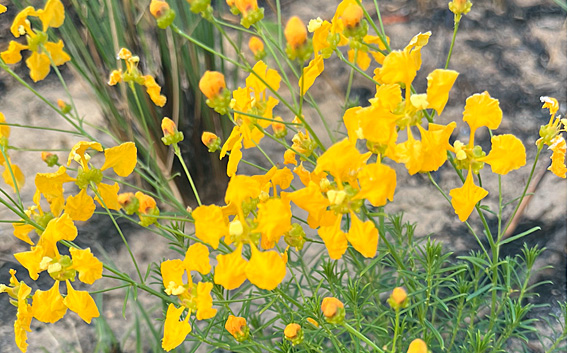


The plants’ bulky roots and underground systems allow them to store carbon effectively (photo: Camarea ericoides / Alessandra Fidelis)
Published on 02/10/2025
By José Tadeu Arantes | Agência FAPESP – When one thinks of the Brazilian Cerrado biome, the images that come to mind are of savannahs with twisted small or medium-sized trees, or open fields with waving grasses and solitary trees. However, a lesser-known group of plants, the non-grass herbaceous plants, play a fundamental role in maintaining this type of biome and in the lives of its inhabitants – animals and humans.
This is the subject of an article published in the Annual Review of Ecology, Evolution, and Systematics. The review study, conducted by an international collaboration of researchers, examined the ecological role of these plants in savannahs and grasslands. It shows that non-grass herbaceous plants are essential for biodiversity, carbon storage, regeneration after disturbance, and the provision of ecosystem services such as food and medicine.
According to researcher Alessandra Fidelis of the Institute of Biosciences of São Paulo State University (IB-UNESP), one of the authors of the study supported by FAPESP, these plants are often overlooked in studies that prioritize grasses and trees. “Many of these plants have specialized underground structures, such as rhizomes and xylopodia, that make them incredibly resilient to the droughts, herbivory and frequent fires that characterize environments like the Cerrado,” she says.
The Cerrado, for example, is home to species such as evergreens, terrestrial orchids and golden grass, some of which flower soon after fire, creating lush landscapes in the post-burn period. These plants make up as much as 70% of the herbaceous layer in some areas and are essential for ecosystem regeneration. In addition, their roots and extensive underground systems allow them to effectively store carbon, a critical aspect in the context of the current climate emergency.
“It’s estimated that the underground biomass of non-grass herbaceous plants in the Cerrado exceeds the above-ground biomass by up to 1.5 times. This carbon retention capacity is enhanced by the longevity of their structures, which can last for many years, providing stability to the ecosystem,” Fidelis explains.
As well as sustaining biodiversity, these herbaceous plants are a source of food and medicine. Traditional communities use their roots and leaves as part of their diet or in medicinal preparations. Cassava, although domesticated, is an example of a plant with nutritious roots that stems from this tradition. Other examples include macela, known for its anti-inflammatory properties, and golden grass, used in sustainable handicrafts.
Traditional medicine also recognizes the properties of Eryngium pristis, used as a diuretic and to treat mouth and throat ulcers; Vernonia ferruginea, a depurative and diuretic; Anemopaegma arvense (catuaba), a tonic for the nervous system and a sexual stimulant; Camarea affinis (pé-de-perdiz), for uterine inflammation and childbirth; Gomphrena officinalis (paratudo), for fever, flu and asthma; and Sisyrinchium vaginatum (king grass), for fever and colds. Among the fruit trees, Annona warmingiana (araticum-rasteiro), Pradosia brevipes (fruta-do-tatu), Ananas ananassoides (pineapple) and Bromelia balansae (gravatá) stand out.
“In Africa, DNA analysis in the feces of large herbivores has shown that they consume many of these plants, even for self-medication. The studies suggest that animals such as elephants and antelopes ingest these species to alleviate disease or parasites, a behavior also observed in primates,” Fidelis points out.
Like everything else in the Cerrado, non-graminoid herbaceous plants face serious threats from deforestation, land conversion for agriculture, and invasion by exotic species. Activities such as deep plowing can destroy their underground structures, making natural regeneration impossible. “These plants are very resilient to fire and herbivory, but extremely sensitive to disturbances that upset the soil,” says Fidelis.
It should be remembered that 46% of the Cerrado’s original vegetation has already been lost to agriculture, which has had a profound impact on local biodiversity. In addition, inappropriate management practices, such as uncontrolled burning and the introduction of invasive species, such as African grasses, greatly exacerbate the scenario.
In this context, adaptive management practices such as controlled burning can help conserve these species. “In the Cerrado, for example, the use of prescribed burns promotes the rapid flowering of species such as some evergreens and canelas-de-ema [Vellozia], favoring the regeneration of the ecosystem,” says the researcher.
The study also highlights the need to integrate these plants into restoration projects. Currently, many initiatives focus only on grasses and trees, neglecting non-grass herbaceous plants. “Active restoration, with planting of native species, direct seeding and translocation of seed-rich soils and subsurface structures, can be an effective, albeit costly, strategy. That’s why avoiding the conversion of natural areas is still the best way to preserve these ecosystems,” says Fidelis.
There is another element that is gaining attention in sustainable landscaping projects: the use of these plants in urban areas. Native species, such as terrestrial orchids, are being incorporated into green spaces to help sustain pollinators and promote aesthetics that are more in tune with the natural context.
Although understudied, non-grass herbaceous plants are a key component of tropical savannah mosaics. Not only do they support complex biological communities, but they also provide essential services to humans. “We hope that this study will draw attention to the importance of this group and encourage further research. The integration of scientific knowledge and traditional knowledge is essential to ensure the conservation of these plants and the ecosystems they support,” concludes Fidelis.
The study “Past, Present, and Future of Forbs in Old-Growth Tropical and Subtropical Grasslands” can be accessed at www.annualreviews.org/content/journals/10.1146/annurev-ecolsys-102722-022331.
Source: https://agencia.fapesp.br/53912